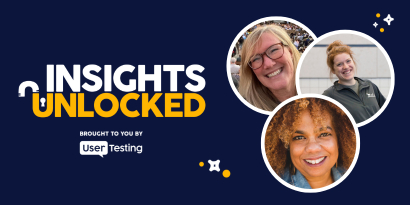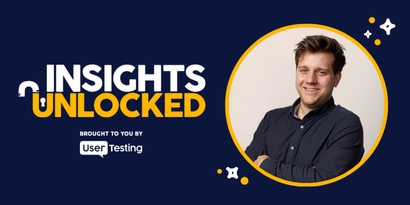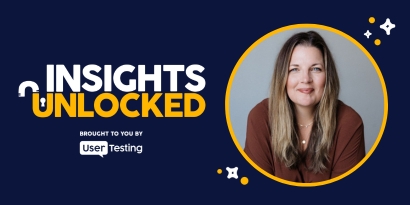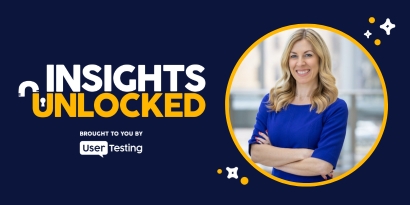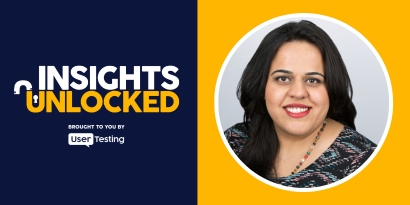
Episode 25 | December 13, 2021
How customer feedback drives UX at Health Catalyst
Discover how Health Catalyst uses customer feedback to drive UX strategy, scale design, and create outcomes that matter in healthcare and B2B tech.
How customer feedback is transforming UX strategy at Health Catalyst
What if the biggest roadblock to innovation wasn’t budget, bandwidth, or buy-in—but opinions?
In this episode of Insights Unlocked, we chat with Andrew Frueh, Senior Vice President of User Experience at Health Catalyst, who reveals how customer feedback has become the cornerstone of decision-making in one of healthcare’s most complex and regulated environments. Through candid insights and hard-won lessons, Andrew explains how his team scales data-driven design across a growing organization, connects deeply with niche B2B users, and builds better products through smarter, more focused testing.
Redefining the power of customer feedback
Andrew Frueh doesn’t mince words when it comes to the value of listening to users.
"What you can really do by investing in customer feedback is very quickly change the conversation."
At Health Catalyst—a data and analytics company serving large healthcare systems—Andrew’s UX team is small but mighty. With only about 10–15 designers supporting a company of 1400, they rely on customer insight to guide their approach. But they don’t just gather feedback—they use it to shift conversations from subjective opinions to objective action.
“It’s not about my opinion versus your opinion. It’s about here’s an idea, here’s some data on how users responded. And based on that data, what actions are we going to take?”
This mindset anchors the team’s approach to UX strategy, where research isn’t an afterthought—it’s a catalyst.
Guide
Competitive analysis with UserTesting
This guide provides ideas for how UserTesting can help you better understand your competitive differentiators and identify areas of opportunity according to your exact audiences.
The anatomy of a small, scalable UX team
With limited headcount, Andrew’s team doesn’t divide roles between UX research and design. Instead, each team member wears multiple hats, blurring the lines between research, usability testing, and product design.
"We unfortunately don’t really have the luxury of distinguishing between specific UX researchers and UX designers. We have to wear all those hats."
But this constraint has fostered a scrappy, micro testing-focused culture. Rather than rely on long, benchmark studies, the team prioritizes quick, actionable insights—what Andrew calls "just-in-time" feedback.
Benefits of this approach:
- Immediate validation or redirection of design choices
- Stronger collaboration between UX, engineering, and product management
- Faster incorporation of feedback into backlogs and roadmaps
“We get the most bang for our buck focusing on micro testing... what’s the thing the team is working on right now, and how can we help shape it?”
Bringing empathy to data-rich, high-stakes UX
Healthcare is a unique beast. High regulation, complex datasets, and deeply sensitive user needs set it apart from consumer-focused industries. But it’s precisely in this context where customer-centric design shines.
Health Catalyst, as Andrew explains, isn't just about storing data—it’s about using that data to drive outcomes: better care, shorter hospital stays, and even lives saved.
“We’re a data company, but we like to think of ourselves as an outcomes company.”
In such high-stakes environments, usability testing becomes more than an exercise in button placements. It becomes a way to ensure critical workflows are seamless, efficient, and aligned with users’ needs—whether that’s a hospital analyst or a clinical services partner.
Why data-driven design works better in B2B healthcare
Unlike retail or financial services, the buyer is almost never the user in B2B healthcare. That creates a delicate balancing act between what gets sold and what actually gets used.
“In many cases, the buyer and the user are very different from each other... that creates some pretty interesting strategic challenges.”
Andrew emphasizes that UX teams in these spaces must dig deeper, leveraging human insight to bridge gaps between intention and experience. One of the biggest shifts in his own approach came from embracing the niche nature of Health Catalyst's users—not scaling away from them.
“We have a much smaller user base... but that gives us the opportunity to build real, meaningful relationships with users that wouldn’t be possible in B2C.”
This direct access has empowered the UX team to act as honest brokers—facilitating peer-to-peer conversations between users, not just interfacing through sales or customer success.
“UX is in a really great position to connect users to users, not just buyers to buyers.”
Building a design system that actually scales
As Health Catalyst grew from 200 to over 1400 employees, consistency and scalability became top priorities. Andrew’s solution? Treating the design system like a product in itself.
“We started with a simple PDF style guide, but quickly realized that wasn’t sustainable. Now our design system, Kashmir, is embedded in product backlogs across the company.”
This shift allowed UX to extend influence across teams without micromanaging every implementation. And because the system was built collaboratively—with developers, technical writers, and analysts—it felt owned by everyone.
Key lessons from scaling their design system:
- Treat it like a shared product with dependencies, governance, and priorities
- Automate documentation and focus on practical, example-driven support
- Ensure code quality and rigor to maintain trust in the system
The result? Analysts, many of whom had no design background, now use system components to build more effective dashboards and tools—without reinventing the wheel.
“Our analysts don’t want to be designers. We want to equip them to focus on what they’re really good at—pulling insights from data.”
Measuring UX impact without getting lost in the metrics
Quantifying the impact of customer experience efforts is notoriously tough, especially in B2B. Andrew’s team has focused less on vanity metrics and more on coverage—how many parts of the organization the UX team touches.
“Our biggest KPI has been: how much of what customers are seeing has UX had a hand in?”
This bottom-up approach—focusing on high-quality work that spreads organically—has earned the team credibility and influence. Now, as a centralized UX organization, they’re well-positioned to formalize broader KPIs that tie back to both product success and customer outcomes.
“Good work gets noticed. That’s how you build design culture from the ground up.”
Lessons learned: Tailor the UX playbook to your industry
One of the most compelling takeaways from Andrew’s journey is how much context matters. Many UX leaders try to apply B2C playbooks to B2B industries—and quickly discover it doesn’t fit.
“I spent years trying to put a round peg in a square hole—applying B2C strategies to a B2B healthcare space. But we had different challenges and opportunities.”
Now, instead of trying to emulate Silicon Valley giants, Andrew and his team focus on what’s uniquely powerful about their position: small user bases, high stakes, and the ability to build close, enduring relationships with users.
Build empathy, one conversation at a time
At the end of the day, Andrew believes that real transformation in customer experience happens when teams stop guessing and start listening.
Whether it’s through just-in-time micro testing, building a shared design system, or amplifying user-to-user connections, the lesson is clear: customer feedback isn’t just data—it’s a conversation starter.
“If you can actually run a test the right way, and be neutral about the data, then everyone wins.”
Episode links:
- Making the case for content testing in your organization: This webinar features insights on advocating for content testing within a company, emphasizing the importance of customer feedback in enhancing user experience.
- UserTesting use case guidebook: This guidebook provides examples of how various businesses utilize user insights to improve customer experiences, showcasing the impact of data-driven design decisions.
- Common usability testing questions: This blog post offers guidance on crafting effective usability test questions, a crucial component of gathering meaningful customer feedback to inform design strategies.
